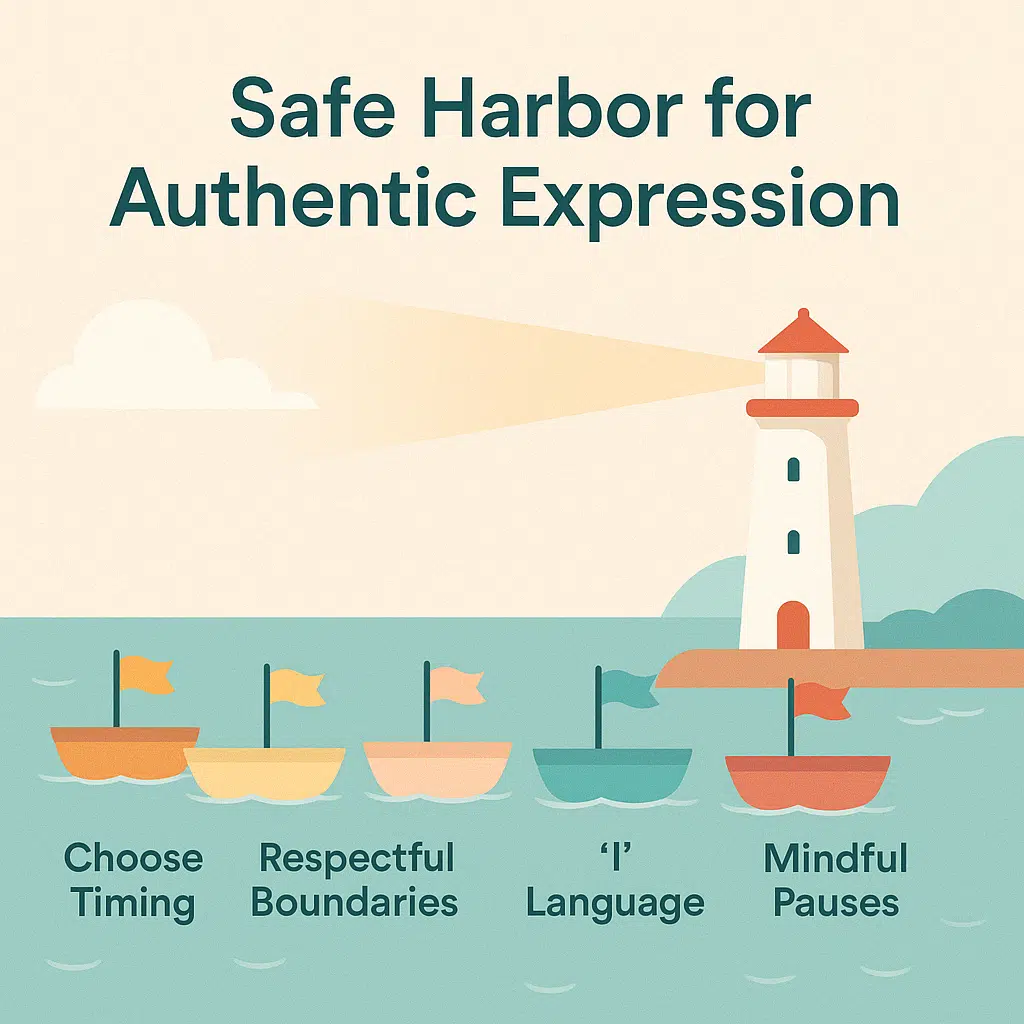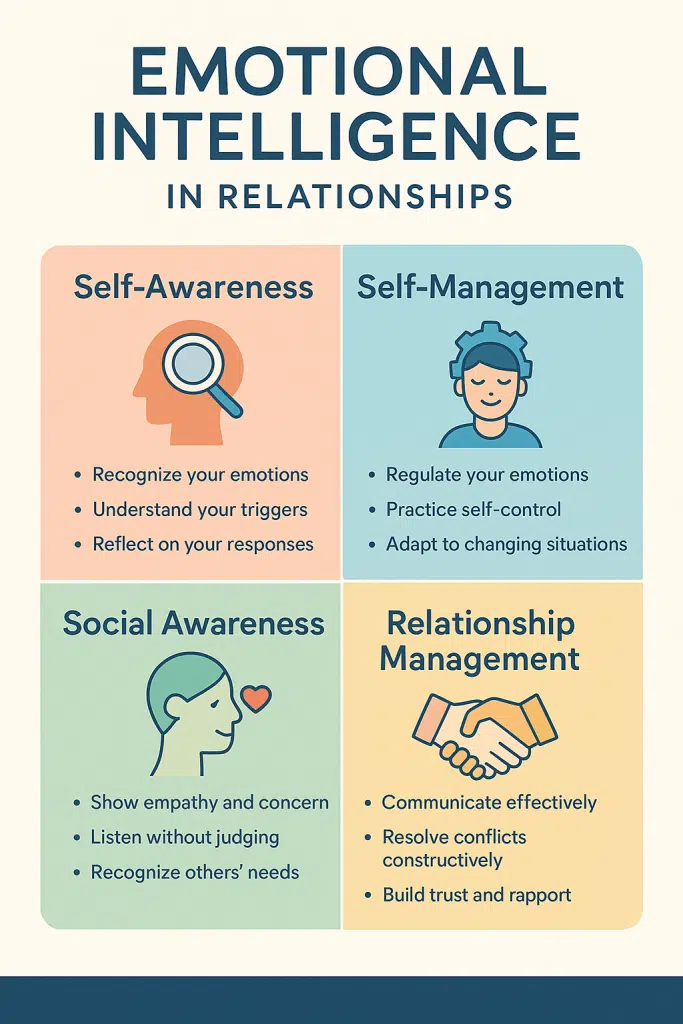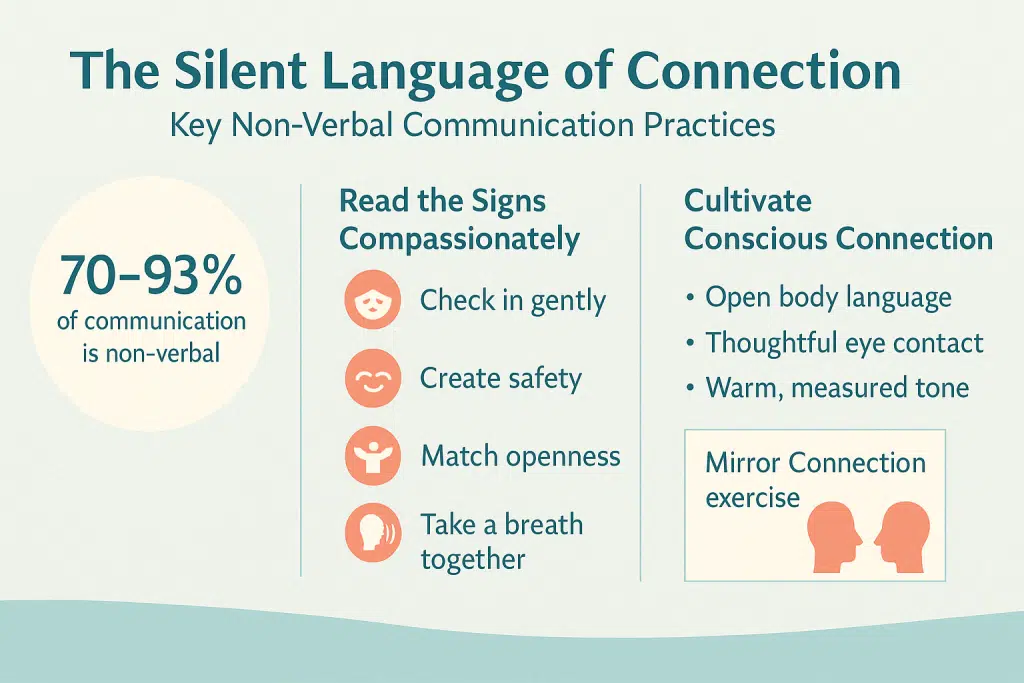Have you ever felt that invisible wall between you and your partner, where words seem to bounce off rather than bridge the gap? Those moments when conversations transform into heated arguments or uncomfortable silences aren’t signs of a doomed relationship—they’re invitations to develop deeper connection skills.
At its heart, effective communication isn’t about perfect words or endless emotional processing. It’s about creating a secure foundation where both partners feel seen, heard, and understood. Without this foundation, misunderstandings compound and emotional distance grows—but with intentional practice, every conversation becomes an opportunity to strengthen your bond.
Let’s explore the practical steps that can transform your communication patterns and nurture the secure connection you both deserve.
Creating a Safe Harbour for Authentic Expression

Before meaningful dialogue can unfold, both partners need to feel emotionally safe. This sacred space doesn’t happen by accident—it’s deliberately cultivated through these intentional practices:
Choose Timing with Care
Notice when you and your partner are most receptive to important conversations. Avoid initiating difficult discussions during times of stress, fatigue, or external pressures. Instead, gently ask: “I’d like to talk about something important. Would now be a good time, or should we find a quieter moment?”
Establish Respectful Boundaries
Together, create agreements that honour both of your needs:
- Practice giving each other uninterrupted time to speak
- Commit to maintaining calm, regulated tones
- Honour the need for brief pauses if emotions intensify
Embrace “I” Language
The words we choose create either bridges or barriers. Replace accusatory language with expressions that honour your experience without blaming your partner:
Instead of: “You never listen to me.”
Try: “I feel disconnected when I don’t feel heard. I’d like to share what’s on my mind.”
Validate Each Other’s Emotional Reality
Validation doesn’t mean agreement—it signals understanding and respect. Simple acknowledgments create profound connection:
- “I can see why you’d feel that way.”
- “Your perspective makes sense to me.”
- “Thank you for trusting me with your feelings.”
Connection Insight: When partners feel emotionally safe, defences naturally lower, creating space for genuine understanding to emerge.
Practice Mindful Pauses
When emotions intensify, agree to take compassionate breaks. Rather than walking away indefinitely, which can trigger abandonment fears, create a specific plan:
“I notice I’m feeling overwhelmed right now. Could we take 15 minutes to collect our thoughts and then reconnect to continue our conversation?”
Common Communication Patterns That Block Connection
Understanding the patterns that undermine intimacy is the first step toward transformation. These patterns often develop unconsciously, often reflecting communication styles we witnessed in our families of origin:
|
Pattern |
What It Looks Like |
Healing Approach |
|
Emotional Withdrawal |
Physically or emotionally distancing during difficult conversations |
“I notice I need some space. I’m committed to returning in 30 minutes so we can work through this together.” |
|
Critical Communication |
Focusing on what’s wrong rather than what’s needed |
Replace judgments with specific, gentle requests that invite connection |
|
Mind-Reading |
Making assumptions about partner’s thoughts or intentions |
“I’m noticing I’m making assumptions. Could you help me understand what you’re actually thinking?” |
|
Defensive Reactions |
Protecting ourselves rather than understanding our partner |
Take a breath, listen fully before responding, and validate before expressing your perspective |
|
Interrupting |
Speaking over partner, preventing full expression |
Practice extended listening periods where each partner has uninterrupted time to share |
The Transformative Power of Active Listening
At the heart of emotional connection lies the ability to truly hear each other. Active listening transcends simply waiting for your turn to speak—it’s about being fully present with your partner’s experience.
Research consistently shows that couples who practice deep listening experience greater relationship satisfaction, emotional intimacy, and conflict resolution success.
The Four Pillars of Active Listening
- Give Your Complete Presence
Set aside distractions, maintain gentle eye contact, and orient your body toward your partner. Your non-verbal cues communicate: “You have my full attention.” - Offer Affirming Responses
Simple acknowledgments like nodding, appropriate facial expressions, and gentle verbal affirmations (“I’m listening,” “I understand”) create a continuous feedback loop that encourages sharing. - Reflect Understanding
Periodically summarize what you’re hearing:
Partner: “I’ve been feeling overwhelmed with all the family obligations.”
You: “It sounds like you’re feeling the weight of our family responsibilities and need more support. Is that right?” - Ask Curious, Open Questions
Instead of interrogating or problem-solving, ask questions that invite deeper sharing:
“Can you tell me more about that experience?”
“What would feel supportive to you right now?”
Active Listening Practice: The Sacred Exchange
Try this structured exercise to strengthen your listening muscles:
|
Time |
Partner A |
Partner B |
|
3 minutes |
Shares feelings and experiences without interruption |
Listens with full presence, without planning responses |
|
2 minutes |
Listens as Partner B reflects understanding |
Summarizes what was heard, checking for accuracy |
|
2 minutes |
Clarifies any misunderstandings and deepens sharing |
Continues listening and reflecting |
Then switch roles, allowing each partner equal time for expression and listening.
Connection Insight: Active listening isn’t passive—it’s one of the most powerful acts of love you can offer your partner.
Expressing Needs and Feelings with Clarity and Compassion
Many of us grew up without models for healthy emotional expression. The good news is that clear communication is a learnable skill that grows stronger with practice.
The Art of “I” Statements
This simple framework creates safety while expressing difficult feelings:
“I feel [emotion] when [situation occurs], and I would appreciate [specific request].”
Examples:
- “I feel anxious when plans change unexpectedly. I would appreciate a quick text if you’re running late.”
- “I feel disconnected when we go several days without quality time. I’d love to set aside one evening a week just for us.”
Transforming Blame into Connection
|
Instead of Blame |
Try Connection-Focused Language |
|
“You never help with household responsibilities.” |
“I feel overwhelmed managing household tasks alone. Could we create a system that feels fair to both of us?” |
|
“You’re always on your phone instead of talking to me.” |
“I miss our conversations and connection. I’d love to have some phone-free time together each day.” |
|
“You don’t respect my feelings.” |
“When my feelings aren’t acknowledged, I feel invisible. It would mean a lot to me if we could talk about this.” |
Remember that even the most skillful communication may feel awkward at first. With practice, these new patterns become natural expressions of your care for each other.
Cultivating Emotional Intelligence in Your Relationship

Emotional intelligence—the ability to recognize, understand, and respond effectively to emotions—forms the foundation of a securely attached relationship. This isn’t about suppressing feelings but learning to navigate them together with wisdom and care.
Understanding Your Emotional Landscape
Begin by recognizing your own emotional patterns and triggers. These sensitivities often have roots in early experiences and previous relationships:
|
Common Trigger |
Underlying Need |
Healthier Request |
|
Feeling criticized |
Validation and acceptance |
“I’m feeling sensitive to feedback right now. Could you acknowledge what I’m doing right before suggesting changes?” |
|
Feeling ignored |
Connection and significance |
“When I don’t get a response, my attachment system gets activated. A brief acknowledgment helps me feel secure.” |
|
Feeling controlled |
Autonomy and respect |
“I need to feel that my choices are respected. Can we find a solution that honors both our needs?” |
Reflection Exercise: Together, identify your core emotional triggers and discuss how you can support each other through vulnerable moments.
The Gift of Empathic Response
When your partner shares difficult feelings, empathy creates a healing connection:
- Acknowledge their emotional experience:
“I can see you’re feeling really disappointed right now.” - Validate the legitimacy of their feelings:
“It makes perfect sense you’d feel that way given what happened.” - Offer presence before solutions:
“Would it help to talk more about it, or would you prefer support in another way?”
Expanding Your Emotional Vocabulary
The ability to name feelings with precision helps both partners navigate emotional terrain:
|
Basic Emotion |
More Specific Expressions |
|
Angry |
frustrated, irritated, exasperated, indignant |
|
Sad |
disappointed, discouraged, melancholy, grief-stricken |
|
Happy |
content, joyful, grateful, peaceful, excited |
|
Anxious |
apprehensive, nervous, overwhelmed, worried |
Self-Regulation Practices for Emotional Conversations
When emotions intensify, these techniques help maintain connection:
- Practice rhythmic breathing (4-count inhale, 7-count hold, 8-count exhale)
- Use grounding techniques that engage your senses
- Name your emotions without judgment: “I notice I’m feeling defensive right now”
Connection Insight: Emotional intelligence creates a relationship where both partners can be authentically vulnerable without fear of judgment or rejection.
The Silent Language: Understanding Non-Verbal Communication

While words matter deeply, our bodies often communicate more powerfully than our voices. Research suggests that between 70-93% of our communication occurs non-verbally through facial expressions, body positioning, tone, and gestures.
When verbal and non-verbal messages align, trust deepens. When they conflict, confusion and distrust emerge.
Reading Non-Verbal Signals With Compassion
|
Non-Verbal Cue |
Possible Meaning |
Compassionate Response |
|
Crossed arms, turned away body |
Self-protection, emotional distance |
Notice without judgment; gently check in: “I notice you seem distant. Is everything okay?” |
|
Limited eye contact |
Discomfort, shame, or feeling overwhelmed |
Create safety: “Take whatever time you need. I’m here when you’re ready.” |
|
Open posture, leaning forward |
Engagement, interest, connection |
Respond with similar openness, affirming the connection |
|
Tense voice or sharp tone |
Stress, anxiety, or feeling threatened |
De-escalate: “Let’s pause and take a breath together.” |
Cultivating Conscious Non-Verbal Connection
- Practice Open Body Language
Uncross limbs, face your partner, and maintain a relaxed posture that signals receptivity. - Use Eye Contact Thoughtfully
Gentle, consistent eye contact communicates presence without dominance or intimidation. - Attune Your Voice to Your Message
A warm, measured tone creates safety even during difficult conversations.
Practice Exercise: The Mirror Connection
Sitting face-to-face, take turns mirroring each other’s gentle movements and expressions. This exercise builds attunement and non-verbal awareness, strengthening your capacity to read and respond to each other’s emotional cues.
Navigating Difficult Conversations with Grace
Every relationship faces challenging conversations. The difference between couples who thrive and those who struggle isn’t whether they have difficult discussions—it’s how they approach them.
Creating a Container for Challenging Conversations
- Begin with Connection
Start gently, affirming your care before addressing concerns:
“This relationship matters deeply to me, which is why I’d like to talk about something that’s been on my mind.” - Create Structure
Take turns speaking and listening, allowing each person equal time to share their experience without interruption. - Honor Emotional Activation
Recognize when physiological arousal signals a need for pause:
“I notice I’m feeling activated right now. Could we take a 15-minute break to regulate our nervous systems before continuing?”
De-escalation Practices for Heightened Moments
|
When You Notice |
Try This Response |
|
Rising tension |
“Let’s slow down and remember we’re on the same team.” |
|
Defensive reactions |
“I’m not trying to criticize. I’m sharing because I care about our connection.” |
|
Feeling personally attacked |
“I’m struggling to listen openly right now. Could you rephrase that in a way that feels less blaming?” |
Conversation Framework for Difficult Topics
Example: Addressing financial concerns
Instead of:
“You’re so irresponsible with money. You never stick to our budget!”
Try:
“I’ve been feeling anxious about our financial situation. I’d like to explore how we might create more security and alignment in our approach to finances. Would you be open to that conversation?”
Connection Insight: Difficult conversations, handled with care and respect, often become doorways to deeper intimacy and understanding.
Establishing Healthy Boundaries in Communication
Contrary to popular misconception, boundaries aren’t walls that separate—they’re guardrails that create safety for authentic connection. Clear boundaries communicate respect for both yourself and your partner.
The Purpose of Communication Boundaries
Healthy boundaries protect the emotional well-being of both partners while creating clear expectations that prevent misunderstandings and resentment.
Essential Communication Boundaries to Consider
- Agreeing to pause conversations when voices rise above conversational volume
- Committing to avoid character attacks or contemptuous language
- Honoring each other’s privacy and confidentiality needs
- Respecting differences in processing styles and timing
Communicating Boundaries with Love
- Identify Your Essential Needs
Reflect on which communication patterns feel harmful or unsafe for you. - Express Boundaries Clearly and Kindly
“I need our conversations to remain free from certain behaviors like name-calling or bringing up past mistakes. This helps me stay present and open.” - Establish Mutual Understanding
Create shared agreements about what happens when boundaries are approached:
“If either of us starts using blaming language, let’s agree to pause and reset.”
Healthy vs. Unhealthy Boundaries
|
Unhealthy Boundary |
Healthy Boundary |
|
“You can’t ever disagree with me in front of others.” (Controlling) |
“I’d appreciate if we could discuss significant disagreements privately first.” (Respectful) |
|
“You have to respond to my texts immediately.” (Demanding) |
“When I don’t hear back for several hours, I worry. Could we agree on reasonable response expectations?” (Needs-based) |
Boundary Check-In Practice:
Schedule regular conversations to assess how your communication boundaries are working:
- “Are there any boundaries you need that you haven’t expressed?”
- “How are our current agreements working for you?”
- “What adjustments might help us communicate more effectively?”
Connection Insight: Clear boundaries aren’t restrictions—they’re the framework that allows authentic intimacy to flourish.
Healing Misunderstandings with Presence and Patience
Misunderstandings are inevitable in relationships. What matters isn’t preventing them entirely but developing the skills to address them with compassion and clarity before they create lasting disconnection.
Understanding Why Misunderstandings Occur
Even in loving relationships, misunderstandings happen when:
- Partners interpret the same words differently based on personal experiences
- Emotions color perception and memory
- Unspoken expectations create confusion
- Different communication styles create unintentional friction
A Pathway to Clarity and Reconnection
- Seek Understanding Before Resolution
“I think we might be misunderstanding each other. Can we slow down and explore what each of us is really trying to express?” - Acknowledge the Disconnect Without Blame
“It seems we’re not quite on the same page. That happens sometimes, and it’s no one’s fault.” - Clarify Through Reflective Listening
“Let me see if I understand correctly. You’re saying that…” - Validate Even When Disagreeing
“I can see how you’d interpret things that way, given your experience.” - Create a Shared Understanding Moving Forward
“To prevent similar misunderstandings, could we agree to…”
The Healing Power of Genuine Apology
When misunderstandings lead to hurt feelings, sincere apologies rebuild trust:
- Acknowledge specific impact: “I can see my words hurt you.”
- Express genuine remorse: “I feel sad knowing I contributed to your pain.”
- Commit to growth: “Next time, I’ll pause to consider how my words might land.”
Practical Solutions for Common Misunderstandings
|
Misunderstanding Type |
Prevention Practice |
|
Schedule confusion |
Create a shared digital calendar with important dates and commitments |
|
Tone misinterpretation |
Move sensitive conversations from text to voice or in-person |
|
Expectation mismatch |
Explicitly discuss hopes and needs rather than assuming agreement |
Connection Insight: Misunderstandings, when addressed with care, often lead to deeper understanding and stronger bonds than existed before.
Creating Communication Rituals That Nurture Connection
Consistent communication rituals create a foundation of security and connection that supports your relationship through both challenges and celebrations. These intentional practices prevent disconnection and foster continuous growth together.
Why Communication Rituals Matter
Regular communication practices create predictability that nurtures attachment security while ensuring important conversations don’t get lost in busy lives. Research shows couples who maintain consistent connection rituals report higher relationship satisfaction and resilience during challenging times.
Meaningful Rituals to Consider
- Daily Check-In Practice (10-15 Minutes)
Set aside distraction-free time each day to share genuine responses to questions like:- “What brought you joy today?”
- “What felt challenging today?”
- “How did you feel most connected to/disconnected from yourself or others today?”
- Weekly Relationship Reflection (30 Minutes)
Create a regular time for deeper conversation about your relationship:- Share appreciations and gratitude
- Discuss any minor concerns before they grow
- Celebrate growth and positive changes
- Plan meaningful time together
- Monthly Relationship Vision Conversation
Dedicate time to nurturing your shared dreams and addressing larger relationship patterns:- Reflect on how you’re growing individually and as a couple
- Discuss progress toward shared goals
- Address any recurring challenges with compassion
Sample Weekly Communication Ritual
|
Day |
Practice |
Purpose |
|
Daily |
10-minute connection check-in |
Maintain emotional attunement |
|
Sunday evening |
30-minute relationship reflection |
Process the week and prepare for the next |
|
First weekend monthly |
Extended conversation and shared activity |
Deepen intimacy and address larger patterns |
Beginning New Rituals With Ease
Starting new communication practices can initially feel unnatural. Approach this growth with patience:
- Start small and specific:
“I’d love for us to try a 10-minute check-in each evening. What do you think?” - Maintain consistency with flexibility:
Honor the commitment to connect while adapting to life’s unpredictability. - Celebrate the effort:
Acknowledge your shared commitment to growth, regardless of how each conversation unfolds.
Connection Insight: Communication rituals create a secure base from which your relationship can weather challenges and celebrate joys.
Inviting Feedback: A Practice in Vulnerability and Growth
The willingness to invite and receive feedback requires courage—and offers tremendous rewards. This practice creates a relationship culture of continuous growth and mutual investment in each other’s happiness.
Creating Safety for Honest Feedback
Approach feedback conversations with genuine curiosity and care:
- Ask open-ended questions:
“What’s one thing I could do differently to help you feel more understood?” - Create emotional safety:
“I really want to understand your experience. I might feel sensitive at times, but your perspective matters deeply to me.” - Listen with presence:
Receive feedback without interrupting or defending, allowing your partner to feel fully heard. - Express gratitude:
“Thank you for being honest with me. Your willingness to share helps us grow closer.”
Receiving Feedback with Grace
|
Instead of This Reaction |
Try This Response |
|
“That’s not what I meant!” |
“I didn’t realize it came across that way. Can you tell me more?” |
|
“Well, you do the same thing!” |
“I hear you. Let’s focus on understanding this pattern first.” |
|
Withdrawing or shutting down |
“This feels hard to hear. Can you help me understand with a specific example?” |
Responding Constructively to Difficult Feedback
- Pause before responding to allow your initial defensive reaction to settle
- Seek clarity about exactly what your partner is experiencing
- Validate their perceptions even if they differ from your intentions
- Commit to specific growth rather than general promises
Creating a Feedback-Friendly Relationship
- Schedule regular, dedicated times for mutual feedback
- Begin with appreciations before addressing concerns
- Focus on specific behaviours rather than character judgments
- Remember that feedback serves connection, not criticism
Connection Insight: A relationship where both partners can safely offer and receive feedback becomes increasingly secure, allowing vulnerability to deepen and authenticity to flourish.
Your Communication Journey: Common Questions
As you implement these communication practices, questions naturally arise. Here are thoughtful responses to common concerns:
“How can I improve communication if my partner seems reluctant?”
Communication transformation often begins with one partner. By consistently practicing these skills yourself—listening deeply, speaking with vulnerability, and maintaining emotional safety—you create an environment where your partner may gradually feel safer to engage. Rather than demanding change, extend invitations: “I’d love to understand your perspective whenever you’re ready to share.”
“We keep having the same arguments. How do we break this cycle?”
Recurring conflicts usually signal deeper attachment needs or unresolved emotional wounds. Rather than focusing on the surface issue, try exploring:
- “What feelings come up for you during this conversation?”
- “What might this conflict be trying to teach us about our needs?”
- “Could we approach this differently by identifying the underlying concerns?”
If the pattern persists despite your best efforts, couples therapy provides a structured environment to understand and transform these cycles.
“How long does it take to see real improvement in communication patterns?”
While some shifts happen immediately—like feeling more understood after a single conversation where active listening is practiced—lasting transformation typically unfolds over months of consistent practice. The neural pathways that drive communication patterns formed over years, and reshaping them requires patience and commitment. Many couples notice significant improvements within 2-3 months of dedicated practice.
“Can difficult communication patterns really change?”
Absolutely. The science of neuroplasticity confirms that new patterns can replace old ones at any age. With intentional practice, even deeply entrenched communication habits can transform. The key ingredients are consistency, self-compassion during setbacks, and celebrating small improvements along the way.
“Is couples therapy necessary for communication improvement?”
While many couples make significant progress using these practices independently, professional support offers distinct advantages:
- Neutral guidance through entrenched patterns
- Structured learning within a safe environment
- Personalized feedback and intervention
- Expert navigation of complex emotional terrain
Consider therapy not as a last resort but as a proactive investment in your relationship’s health and growth.
Resources for Continued Growth
Your commitment to improving communication reflects the value you place on your relationship. These resources can support your ongoing journey:
Books That Transform Relationships
- Hold Me Tight by Dr. Sue Johnson
- The Seven Principles for Making Marriage Work by Dr. John Gottman
- Nonviolent Communication by Marshall B. Rosenberg
Podcasts for Relationship Wisdom
- Where Should We Begin? with Esther Perel
- The Relationship School Podcast with Jayson Gaddis
- Foreplay Radio with Dr. Laurie Watson
Relationship Education Programs
- Emotionally Focused Therapy (EFT) Workshops
- Gottman Method Couples Workshops
- Imago Relationship Workshops
Remember that communication growth isn’t about perfection—it’s about progress. Each conversation is an opportunity to deepen your connection and strengthen the secure bond you’re building together.
At Couples Counselling Centre, we believe that secure attachment and authentic communication create the foundation for lasting love. If you’d like personalized support in transforming your relationship communication, we’re here to help. Our evidence-based approach honours both the science of relationships and the sacred journey of growing together. — Learn more about our couples counselling here.











